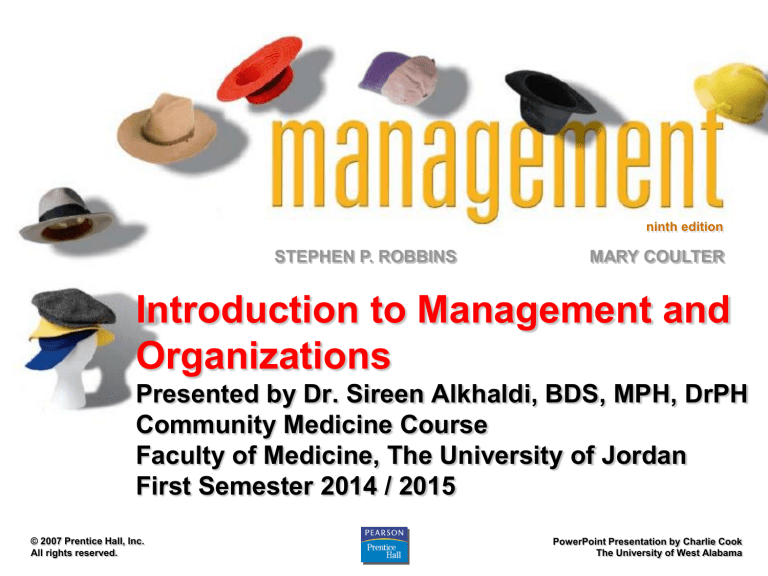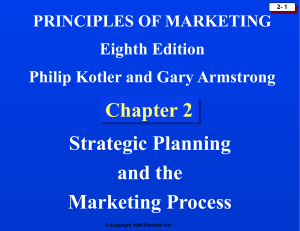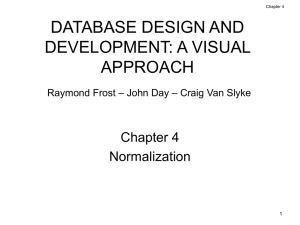What Is Management? - Medicine Batch 2013

© 2007 Prentice Hall, Inc.
All rights reserved.
STEPHEN P. ROBBINS ninth edition
MARY COULTER
Introduction to Management and
Organizations
Presented by Dr. Sireen Alkhaldi, BDS, MPH, DrPH
Community Medicine Course
Faculty of Medicine, The University of Jordan
First Semester 2014 / 2015
PowerPoint Presentation by Charlie Cook
The University of West Alabama
What Is Management?
Management is what managers do.
Management is the attainment of organizational goals in an effective and efficient manner through: planning, organizing , leading , and controlling organizational resources .
• Managerial Concerns
Efficiency
“Doing things right”
– Getting the most output for the least inputs (people, money, …)
Effectiveness
“Doing the right things”
– Attaining organizational goals
© 2007 Prentice Hall, Inc. All rights reserved. 1 –2
Why Study Management?
• The Value of Studying Management
The universality of management
Good management is needed in all types, sizes, and levels of all organizations.
The reality of work
Employees in all jobs either manage or are managed.
Rewards and challenges of being a manager
Management offers challenging, exciting and creative opportunities for meaningful and fulfilling work.
Successful managers receive significant monetary rewards for their efforts.
© 2007 Prentice Hall, Inc. All rights reserved. 1 –3
Exhibit 1 –11 Universal Need for Management
© 2007 Prentice Hall, Inc. All rights reserved. 1 –4
Who Are Managers?
• Manager
Someone who coordinates and oversees the work of other people so that organizational goals can be accomplished.
© 2007 Prentice Hall, Inc. All rights reserved. 1 –5
Classifying Managers Levels
• First-line Managers
Individuals who manage the work of non-managerial employees (e.g. team leaders, supervisors).
• Middle Managers
Individuals who manage the work of first-line managers.
They are in charge of large departments or divisions consisting of several smaller work units (e.g. clinic directors in hospitals and regional manangers).
• Top Managers
Individuals who are responsible for making organizationwide decisions and establishing plans and goals that affect the entire organization. Job titles at this level are: chief executive officer, chief operating officer, president,
1 –6 and vice president.
Exhibit 1 –1 Managerial Levels
© 2007 Prentice Hall, Inc. All rights reserved. 1 –7
Exhibit 1 –2 Effectiveness and Efficiency in Management
© 2007 Prentice Hall, Inc. All rights reserved. 1 –8
The 4 Functions of Management
Planning
Defining goals, establishing strategies to achieve goals, developing plans to integrate and coordinate activities.
Organizing
Arranging and structuring work to accomplish organizational goals.
Leading
Working with and through people to accomplish goals.
Controlling
Monitoring, comparing, and correcting work.
© 2007 Prentice Hall, Inc. All rights reserved. 1 –9
Exhibit 1 –3 Management Functions
© 2007 Prentice Hall, Inc. All rights reserved. 1 –10
What Do Managers Do?
Managerial Skills
Technical skills
The ability to use Knowledge and proficiency or expertise in a specific field
Human skills
The ability to work well with other people (with trust and enthusiasm), and empathize with the emotions and feelings of others (emotional intelligence).
Conceptual skills
The ability to think analytically and conceptualize about abstract and complex situations concerning the organization, to solve problems.
© 2007 Prentice Hall, Inc. All rights reserved. 1 –11
• Examples of Conceptual skills:
a manager conducts an analysis of the best way to provide a service
a manager determines a strategy to reduce patient complaints regarding food service
• Examples of Technical skills:
a manager develops and implements a new incentive compensation program for staff
a manager designs and implements modifications to a computer-based staffing model
• Examples of Human skills:
a manager counsels an employee whose performance is below expectation
a manger communicates to subordinates the desired performance level for a service for the next fiscal year
–12
Exhibit 1 –5 Skills Needed at Different Management Levels
© 2007 Prentice Hall, Inc. All rights reserved. 1 –13
What Is An Organization?
• An Organization Defined
A deliberate arrangement of people to accomplish some specific purpose, that individuals independently could not accomplish alone.
• Common Characteristics of Organizations
Have a distinct purpose (goal)
Composed of people
Have a deliberate structure
© 2007 Prentice Hall, Inc. All rights reserved. 1 –14
What Is An Organization?
• In health care, organizations can take a variety of forms:
For-profit hospitals
Private physicians’ offices
Networks of health care specialists
Community health center
© 2007 Prentice Hall, Inc. All rights reserved. 1 –15
The Purpose of An Organization?
• The PURPOSE of an organization is to produce goods and/ or services that satisfy the needs of the customers.
• Although many organizations focus on producing services (immunizing infants, testing for diseases, treating illnesses, providing longterm nursing care, etc………), all organizations exist because they contribute something useful to the society.
© 2007 Prentice Hall, Inc. All rights reserved. 1 –16
Social Responsibility
What is Social Responsibility?
Management’s social responsibility goes beyond achieving organizational goals and making profits to include protecting and improving society’s welfare.
Firms have a moral responsibility to larger society to become involved in social, legal, and political issues.
“To do the right thing”
Copyright © 2005 Prentice Hall, Inc. All rights reserved. 5 –17
The Greening of Management (Go Green
)
• The recognition of the close link between an organization’s decision and activities and its impact on the natural environment .
• Firms should do what is legally required by obeying laws , rules, and regulations willingly and without legal challenge .
Global environmental problems facing managers:
Air, water, and soil pollution from toxic wastes
Global warming from greenhouse gas emissions
Natural resource depletion
Copyright © 2005 Prentice Hall, Inc. All rights reserved. 5 –18
How Organizations Go Green
• Legal (of Light Green) Approach
Firms simply do what is legally required by obeying laws , rules, and regulations willingly and without legal challenge.
• Market Approach
Firms respond to the preferences of their customers for environmentally friendly products .
• Stakeholder Approach
Firms work to meet the environmental demands of multiple stakeholders
—employees, suppliers, and the community.
• Activist Approach
Firms look for ways to respect and preserve environment and be actively socially responsible .
5 –19
Copyright © 2005 Prentice Hall, Inc. All rights reserved.
Planning
Planning involves two important aspects
Setting Goals (also Objectives)
Desired outcomes for individuals, groups, or entire organizations
Provide direction and evaluation performance criteria
Developing Plans
Documents that outline how goals are to be accomplished
Describe how resources are to be allocated and establish activity schedules
As managers plan, they develop both goals and plans
.
Copyright © 2005 Prentice Hall, Inc. All rights reserved. 7 –20
Characteristics of Well-Designed Goals
• Written in terms of outcomes, not actions
Focuses on the ends, not the means.
• Measurable and quantifiable
Specifically defines how the outcome is to be measured and how much is expected.
• Clear as to time frame
How long before measuring accomplishment.
• Challenging but attainable
Low goals do not motivate.
High goals motivate if they can be achieved.
• Written down
Focuses, defines, and makes goal visible.
• Communicated to all
Puts everybody “on the same page.”
Copyright © 2005 Prentice Hall, Inc. All rights reserved. 7 –21
Strategic Management
• The set of managerial decisions and actions that determines the long-run performance of an organization.
Copyright © 2005 Prentice Hall, Inc. All rights reserved. 8 –22
Strategic Management
Managers ask such questions as...
What changes and trends are occurring?
Who are our customers?
What products or services should we offer?
How can we offer these products or services most efficiently?
© 2007 Prentice Hall, Inc. All rights reserved. 1 –23
Strategic Management
Process
Scan External
Environment –
National,
Global
Identify Strategic
Factors –
Opportunities,
Threats
Evaluate
Current Mission,
Goals,
Strategies
Scan Internal
Environment – Core
Competence,
Synergy, Value
Creation
SWOT
Define new
Mission
Goals, Grand
Strategy
Identify Strategic
Factors –
Strengths,
Weaknesses
Formulate
Strategy –
Corporate,
Business,
Functional
Implement
Strategy via
Changes in:
Leadership culture,
Structure, HR,
Information & control systems








